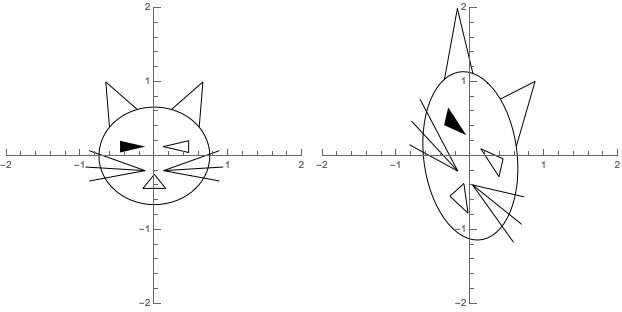I define the "matrix transformation" here as follows: $\left[ \begin{matrix} x_1' \\ x_2' \\ \end{matrix} \right]=\left[ \begin{matrix} a & b \\ c & d \\ \end{matrix} \right]\left[ \begin{matrix} x_1\\ x_2\\ \end{matrix} \right]$, therefore this is a transformation between point and point. it moves $(x_1,x_2)$ to $(x_1',x_2')$ So is there any way to visualize it when you're trying to deform a grid by this?
3 Answers
One classic way to depict the effect of a plane linear transformation is to see what it does to a stylized drawing of a cat's face.
First, a utility to transform points and a function to reflect across the vertical axis:
pointQ[p_] := VectorQ[p, NumberQ] && Length[p] == 2
image[T_, object_] := object /. pt_?pointQ :> T[pt]
reflect[p_] := {-p[[1]], p[[2]]}
Next, design the original cat's face (this cat winks its left eye so as to destroy left-right symmetry of its face):
facexy[j_] := 0.75 { Cos[2 \[Pi] j/60], 0.88 Sin[2 \[Pi] j/60]}
outline = Line[Transpose@facexy@Range[0, 60]];
mouth = Line[{{0, -0.25}, {-0.153, -0.44}, {0.153, -0.44}, {0, -0.25}}];
rightEar = Line[{facexy[6], {0.657, 1.0}, facexy[12]}];
leftEar = reflect~image~ rightEar;
ears = {rightEar, leftEar};
rightEye =
Line[{{0.123, 0.25-0.125}, {0.464, 0.205}, {0.464, 0.045}, {0.123, 0.25-0.125}}];
leftEye = reflect~image~(Polygon @@ rightEye);
eyes = {rightEye, leftEye};
spray[source_, targets_] :=
MapThread[Line, Outer[List, {source}, targets, 1], 1]
rightWhiskers =
spray[{0.125, -0.2}, {{0.88, 0.07}, {0.932, -0.151}, {0.88, -0.34}}];
leftWhiskers = reflect~image~rightWhiskers;
whiskers = Join[rightWhiskers, leftWhiskers];
urCat = Join[{outline, mouth}, ears, eyes, whiskers];
Next, a couple more graphics utilities:
makeFigure[objects_, low_: - 1, high_: 1] :=
Graphics[objects, PlotRange -> {{low, high}, {low, high}},
AspectRatio -> Automatic, Axes -> True, ImageSize -> Scaled[0.3]]
makeFigureAndImage[objects_, T_, low_ : -1, high_ : 1] :=
Row[{makeFigure[objects, low, high], Spacer[10],
makeFigure[image[T, objects], low, high]}]
Finally, a sample linear transformation and the picture of how it distorts the cat's face:
T[p_] := {{0.8, 0.35}, {-0.75, 1.5}}.p
makeFigureAndImage[urCat, T, -2, 2]

The code above "gets back to basics" in that the transformation operates directly upon points and in effect transforms a line segment of a graphical object by forming the corresponding line segment joining the images of the endpoints.
The can be simplified by using the built-in function GeometricTransformation. In particular, the outline of the cat's face can then be prescribed as an ellipse, and the second argument to GeometricTransformation allows direct use of the matrix, without any need to define the linear transformation T. Thus:
newOutline = Circle[{0, 0}, {0.88, 0.75}];
newUrCat = Join[{outline, mouth}, ears, eyes, whiskers];
newMakeFigureAndImage[objects_, mat_, low_ : -1, high_ : 1] :=
Row[{makeFigure[objects, low, high], Spacer[10],
makeFigure[GeometricTransformation[objects, mat], low, high]}]
newMakeFigureAndImage[newUrCat, {{0.8, 0.35}, {-0.75, 1.5}}, -2, 2]
The output will appear identical to that above.
If you want to animate the transformation, showing over time how the cat's face changes from its original shape to the distorted shape, create a table of snapshots and export it, like this:
With[{mat = {{0.8, 0.35}, {-0.75, 1.5}}},
twistingCat =
Table[Row[{makeFigure[newUrCat, -2, 2], Spacer[10],
makeFigure[
GeometricTransformation[
newUrCat, (1 - t) IdentityMatrix[2] + t mat], -2, 2]}],
{t, 0, 1, 0.05}]
];
ListAnimate[twistingCat]
In order to show the effect in this post, I created the list of "frames" for the animation above (which you would directly see inside Mathematica by evaluating the ListAnimate expression; by exporting that as a .gif, then placing that .gif here, you see the animation.
Export["TwistingCat.gif", twistingCat]

With similar techniques you may use one or more parameters in the transformation matrix and dynamically show the effect of varying them.
Note that ordinarily to display a dynamically changing graphic in a Mathematica notebook, I would use `Manipulate, as in:
With[{mat = {{0.8, 0.35}, {-0.75, 1.5}}},
Manipulate[
Row[{makeFigure[newUrCat, -2, 2], Spacer[10],
makeFigure[
GeometricTransformation[newUrCat, (1 - t) IdentityMatrix[2] + t mat], -2, 2]}],
{t, 0, 1, 0.05}]
]
-
$\begingroup$ Thanks. And what about some animations? In other words, what if I vary the parameters in my matrix and I want to see how the deformed picture vary with them? $\endgroup$– pxc3110Commented Apr 21, 2014 at 9:01
-
$\begingroup$ @pxc3110: See the added material at the end showing animation. $\endgroup$– murrayCommented Apr 22, 2014 at 15:56
-
4$\begingroup$ Very nice. But aren't there laws against doing that sort of thing to a cat? $\endgroup$ Commented Sep 21, 2014 at 0:35
-
$\begingroup$ @DanielLichtblau: Perhaps. But I follow the lead of a classic book on differential equations & dynamical systems (was it by Arnold & Aziz) that used a cat's face to illustrate the "baker's transformation". $\endgroup$– murrayCommented Sep 22, 2014 at 21:09
Here's a Manipulate that applies any affine transformation to an image. The 2-by-2 matrix transformation is in the upper 2-by-2 block of the affine function and the {b1,b2} parameters shift the image left-right and up-down.
img = Import["https://i.sstatic.net/pp27n.png"];
Manipulate[
GraphicsRow[{AffineTransform[{{{a11, a12}, {a21, a22}}, {b1, b2}}],
ImageTransformation[img,
AffineTransform[{{{a11, a12}, {a21, a22}}, {b1, b2}}]]}, ImageSize -> {600}],
Row[{Control[{{a11, 1}, -1, 1}], Spacer[20], Control[{{a12, 0.015}, -1, 1}]}],
Row[{Control[{{a21, 0.595}, -1, 1}], Spacer[20], Control[{{a22, 0.415}, -1, 1}]}],
Row[{Control[{{b1, 0.225}, -1, 1}], Spacer[20], Control[{{b2, -0.03}, -1, 1}]}]]

-
1$\begingroup$ Would be nice to include controls for plot range, so that so much of image wouldn't disappear when the default parameters of the linear transformation part are changed. $\endgroup$– murrayCommented Sep 22, 2014 at 21:13
Something like this?
g = FiniteGroupData[{"DihedralGroup", 4}, "CayleyGraph"];
g1 = SetProperty[g, VertexLabels -> "Name"];
l = PropertyValue[{g1, #}, VertexCoordinates] & /@ VertexList[g1];
m = {{2, 1}, {-1, 2}};
Framed@Row[{g1, SetProperty[g1, VertexCoordinates -> (m.# & /@ l)]}]

-
$\begingroup$ Thanks for your answer. Actually I want to deform a picture. If I get a picture, and multiply the representation vetor of every point by an invertible 2 by 2 matrix, then I want to see how this picture looks like after this transformation. $\endgroup$– pxc3110Commented Apr 19, 2014 at 6:06
-
2$\begingroup$ @pxc3110 Try
ImagePerspectiveTransformation[ExampleData[{"TestImage", "Lena"}], {{1/2, 1/10}, {1/10, 1/4}}]$\endgroup$ Commented Apr 19, 2014 at 6:34
